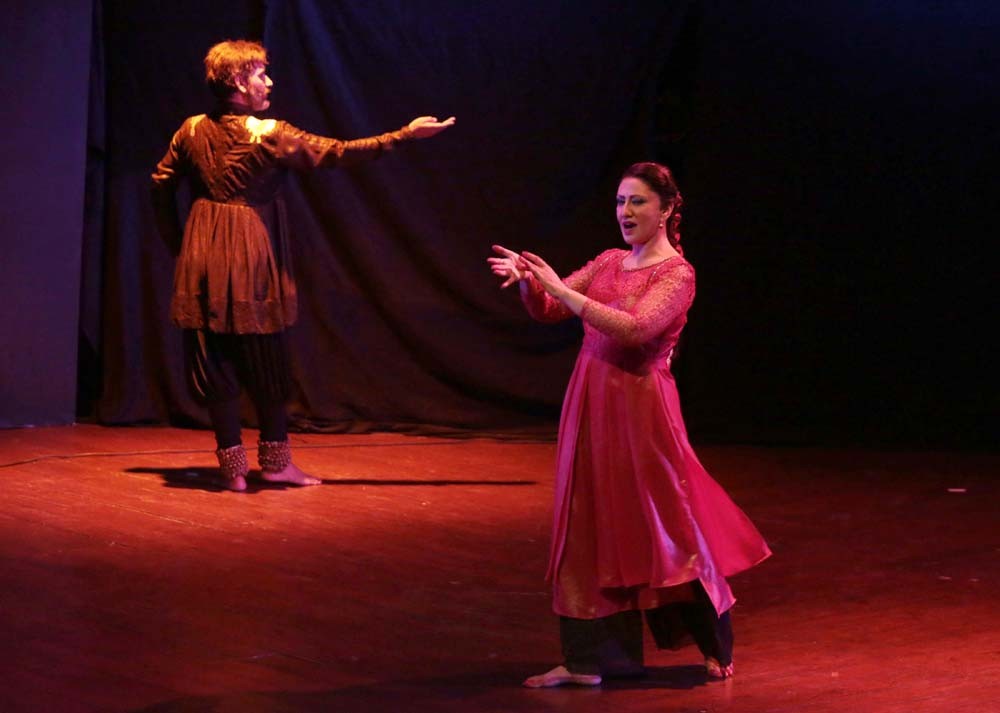
A dance performance in Lahore reclaimed the space for love, harmony and coexistence

In a captivating performance titled ‘Chakkar’, Nighat Chaudhry, Samiya Mumtaz and Adnan Jahangir brought back to the city of Lahore the fading tale of Indian classical dance. Presented by Olomopolo Media, the dance performance was an attempt to make sense of the world around -- to reclaim the space for love, harmony and coexistence in an intolerant and regressive society.
The event opened to a fully-packed hall at Alhamra Arts Council in Lahore on April 3, 2015. The stage was illuminated with a blend of three colours -- red, purple and blue. A group of eight musicians was seated elevated in the background of the stage.
The evening began with a Bharatnatyam recital by Samiya Mumtaz. The large-eyed damsel enthralled the audience by her expressive, vibrant moves and well-balanced postures. Exhibiting her innermost feelings while presenting the piece, she captured the moments of hope, desire and despair inherent in the composition set in Raga Marwa. The composition was followed by a rhythmic pattern in teen taal, which traversed through the vilambat, madhya and dhrut layas.
The presence of red cloth depicted the present world eclipsed by anarchy, chaos and war while Samiya’s movements brought in an instinctive feel of peace and harmony. The fiery footwork by Jahangir and Mumtaz combined with stylised postures which grabbed the attention of dance aficionados, in fact, portrayed the forces of obstruction against the peaceful elements in the society. In a thriving combination of rhythmic pattern and gestural articulation, the narration abounded in its emotive appeal as Mumtaz presented her surrender against the destructive forces. Thus, shunning her fight for freedom, she was ultimately seen getting absorbed by the catastrophe. The scene was well-crafted both in terms of footwork and expressions.
Next, Nighat Chauhdry, clad in a red angrakha took to the stage performing with rigour and energy to a sehra (prothalanium) -- often sung at weddings in praise of the groom. She performed with a prowess demanded by the powerful poetry but somehow compromised on her gestures and body language which affected the artistic value. She was soon joined by Adnan Jahangir and both, in their combined performance, gave a dynamic touch to the evening.
Soon after, a team of 13 girls and boys entered the stage. The girls were dressed in white frocks paired with churidar pajamas while the two boys were clad in black-coloured traditional classical dance costumes. The recital set in Raag Hansdhwani was further enhanced by Rakae Jamil’s impressive sitar performance. The well-articulated group movements demonstrated the quality of instructions bestowed upon the artistes. The piece was remarkable in its presentation as it portrayed the passing on of good will to future generations.
According to Jahangir, Chakkar signifies the vicious cycle of life. He suggests breaking away from it only by opening new windows in the walls around us -- to dissipate the negativity and the mayhem engulfing us.
In the words of a feminist academic, Nabiha Mehr Sheikh, who was present at the event: "When the little girls came on stage, I felt a sense of nostalgia and happiness. It takes courage to allow your daughter to dance so openly on stage in this country."
At the end of the performance, Jahangir talked about his struggle in becoming an expert dancer, thanking his "mentor" Bina Jawad. He also announced another dance production next month.
"The piece can’t be seen as separate performances by the various dancers but in its entirety it gives a meaningful message of peace and harmony to the audience," he said. He added he wants to dedicate the evening to his guru Pandit Rajendra Kumar Gangani of Jaipur Gharana. "Without his support and encouragement, I would not have been able to choreograph such an elaborate narrative."
He visits Delhi twice every year where he stays for a month with his guru to master the art of classical dance in what is termed as the Guru-Shishya tradition.
Samiya Mumtaz added: "There is a need to promote awareness among people about our cultural values through focusing on classical art forms. Not only will it create appreciation for the art but will help imbibe in young minds the concept of peace and tolerance."
The performance spanned a little over an hour, without any slackening moment. Despite the shrill rhetoric, which claims the declining popularity of traditional and classical forms of art among the youth, the dance recital kept the audience spellbound. Perhaps, more such initiatives can help create an appreciation and understanding of the historical aspects and the instinctive beauty of classical dance and its connection with mythology.